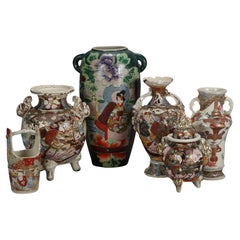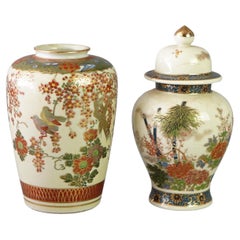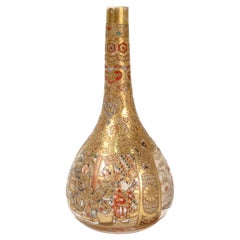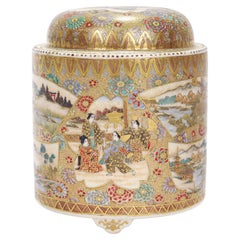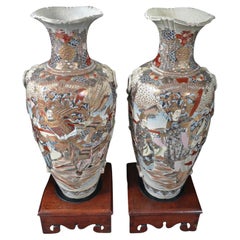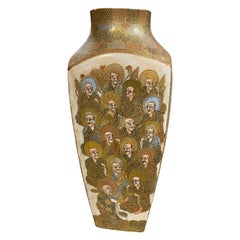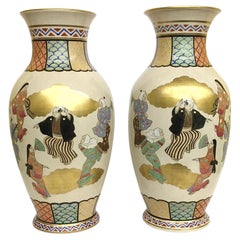Japanese Satsuma Pottery
Early 20th Century Pottery
Pottery
Early 20th Century Asian Ceramics
Pottery
Early 20th Century Asian Ceramics
Ceramic
Early 20th Century Japanese Meiji Ceramics
Pottery
Early 20th Century Meiji Ceramics
Pottery
Early 20th Century Asian Ceramics
Porcelain
Antique Early 1900s Japanese Meiji Ceramics
Pottery
Early 20th Century Japanese Meiji Ceramics
Earthenware, Pottery
Antique Early 1900s Japanese Meiji Pottery
Pottery
20th Century Japanese Meiji Vases
Ceramic
Early 20th Century Pottery
Pottery
Antique 19th Century Japanese Meiji Ceramics
Pottery
Antique Late 19th Century Japanese Pottery
Gold Leaf
Antique 1880s Japanese Meiji Ceramics
Pottery
Early 20th Century Japanese Anglo-Japanese Pottery
Earthenware
Antique Mid-19th Century Japanese Pottery
Porcelain
Antique Late 19th Century Japanese Meiji Ceramics
Ceramic, Pottery
Antique Early 1900s Japanese Meiji Ceramics
Ceramic, Porcelain, Pottery, Stoneware, Hardwood
Antique 19th Century Japanese Meiji Ceramics
Pottery
Antique Late 19th Century Japanese Meiji Ceramics
Pottery
Early 20th Century Japanese Meiji Pottery
Enamel
Antique Late 19th Century Japanese Meiji Ceramics
Pottery
Antique Late 19th Century Asian Meiji Ceramics
Pottery
Antique 19th Century Japanese Meiji Ceramics
Earthenware, Pottery
Early 20th Century Porcelain
Pottery
20th Century Japanese Ceramics
Pottery
Early 20th Century Ceramics
Pottery
Antique 1890s Japanese Meiji Ceramics
Pottery
Antique Early 1900s Japanese Serving Pieces
Pottery
Early 20th Century Asian Porcelain
Pottery
Early 20th Century Vases
Pottery
Antique Early 1900s Japanese Meiji Ceramics
Ceramic, Earthenware, Pottery
Early 20th Century Asian Ceramics
Pottery
Vintage 1930s Japanese Ceramics
Ceramic, Earthenware, Pottery
Antique Early 1900s Japanese Meiji Ceramics
Ceramic, Earthenware, Pottery, Faux Leather
Antique Early 1900s Japanese Meiji Ceramics
Ceramic, Earthenware, Pottery
Antique Early 19th Century Asian Ceramics
Porcelain
Antique Late 19th Century Japanese Meiji Ceramics
Ceramic, Earthenware, Pottery
Antique 19th Century Japanese Vases
Porcelain
Antique Late 19th Century Japanese Meiji Vases
Ceramic, Earthenware, Pottery
Antique 1890s Japanese Meiji Ceramics
Silver
Antique Late 19th Century Japanese Meiji Ceramics
Ceramic, Earthenware, Pottery
Antique Late 19th Century Japanese Meiji Ceramics
Pottery
Early 20th Century Japanese Meiji Vases
Ceramic, Earthenware, Pottery
Antique 19th Century Japanese Decorative Dishes and Vide-Poche
Porcelain
Antique Early 1900s Japanese Meiji Ceramics
Earthenware, Pottery
Antique 19th Century Japanese Meiji Decorative Dishes and Vide-Poche
Porcelain
Antique 19th Century Japanese Vases
Porcelain
Antique Early 1900s Japanese Meiji Ceramics
Ceramic, Earthenware, Pottery
Antique 19th Century Japanese Meiji Vases
Porcelain
Antique Early 1900s Japanese Meiji Ceramics
Ceramic, Earthenware, Pottery
Antique 19th Century Japanese Meiji Vases
Porcelain
Antique 19th Century Japanese Decorative Dishes and Vide-Poche
Porcelain
Antique 19th Century Japanese Meiji Decorative Bowls
Porcelain
Antique Late 19th Century Japanese Meiji Vases
Ceramic, Earthenware, Pottery
Early 20th Century Japanese Showa Ceramics
Pottery
Antique 19th Century Japanese Taisho Vases
Porcelain
Antique Late 19th Century Japanese Meiji Ceramics
Ceramic, Earthenware, Pottery
Antique 18th Century Japanese Edo Vases
Pottery
Vintage 1950s Japanese Ceramics
Ceramic
- 1
Japanese Satsuma Pottery For Sale on 1stDibs
How Much is a Japanese Satsuma Pottery?
- Is Satsuma pottery valuable?1 Answer1stDibs ExpertApril 26, 2024Yes, some Satsuma pottery is valuable. The age, type, style and condition will determine how much a particular piece is worth. In addition, the history of ownership may also make a piece more valuable. For example, if a piece was previously in the collection of a notable person, such as a member of the Japanese Imperial Family, it may be worth more. To get an estimated value for a particular piece, consult a certified appraiser or knowledgeable antiques dealer. Find a range of Satsuma pottery on 1stDibs.
- What is a Japanese Satsuma vase?1 Answer1stDibs ExpertOctober 12, 2021A type of Japanese pottery originated from Satsuma province in Japan is termed as Satsuma ware. A vase of this kind is known as a Satsuma vase. An interesting fact about Satsuma ware is that they feature a "makers mark" or marking as a key to help collectors unlock the value, age and authenticity of the piece. Shop a range of antique and vintage Japanese vases on 1stDibs.
- 1stDibs ExpertNovember 4, 2024To identify Satsuma pottery marks, you'll typically need to perform research using trusted online resources. Satsuma is a region in Japan known for its pottery, and many factories and artisans have operated there, including Kinkozan, Taizan, Yasuda, Choshuzan, Fuzan, Gyozan, Koshida and Maruni Kobe. Each maker has its own marks associated with it, and these typically are in Japanese kanji characters. You can compare the characters on your piece to pictures shared online to find a match. Alternatively, a certified appraiser or experienced antique dealer can help you identify your pottery markings. On 1stDibs, shop a selection of Satsuma pottery.
- 1stDibs ExpertSeptember 9, 2024Yes, some Satsuma pottery is worth something. Depending on their age, maker, type, style, condition and other factors, pieces may sell for a few hundred to several thousand dollars. Looking at sales and auction histories can give you a rough idea of the value of a piece. For a more definitive valuation, use the services of a certified appraiser or knowledgeable antique dealer. On 1stDibs, explore a collection of Satsuma pottery.
- What is Japanese pottery called?1 Answer1stDibs ExpertApril 5, 2022Japanese pottery is called tojiki or yakimono. Various types have names of their own. For example, porcelain made during the Edo period is arita-yaki, while blue and white porcelain is seto-mono. On 1stDibs, shop a selection of Japanese pottery on 1stDibs.
- Is Japanese pottery valuable?1 Answer1stDibs ExpertApril 26, 2024Yes, some Japanese pottery is valuable. Generally, the type, style, age, maker and condition affect how much a particular piece is worth. Some varieties of Japanese pottery that often sell for high prices due to demand among collectors include Imari ware, Mino ware and Seto ware. A certified appraiser or knowledgeable antique dealer can give you specific information about whether a particular piece is valuable. On 1stDibs, shop a diverse assortment of Japanese pottery.
- 1stDibs ExpertApril 5, 2022There are 47 different prefectures in Japan and each one produces ceramic ware and pottery unique to that region. Japanese Pottery, known as Tojiki or Yakimono, combines art and tradition and reflects the culture of the region. Shop a collection of Japanese pottery from some of the world’s top sellers on 1stDibs.
- 1stDibs ExpertMay 3, 2024Opinions vary as to what is the most famous type of Japanese pottery. A few kinds of pottery that originated in Japan have gained fame and are popular with collectors. Among them are Arita or Imari ware, Seto ware, Mino ware, Tokoname ware, Shigaraki ware, Kutani ware and Onta ware. Shop a wide variety of Japanese pottery on 1stDibs.
- 1stDibs ExpertSeptember 23, 2024Japanese blue pottery is called sometsuke. When translated literally from Japanese, the word means "with dye." It refers to the fact that sometsuke pottery gets its beautiful color from applying a cobalt dye underglaze on white bisque ceramic. Find a wide variety of Japanese pottery from some of the world's top sellers on 1stDibs.
- 1stDibs ExpertAugust 8, 2024To tell if your Japanese pottery is antique, look for markings, which usually appear on the bottoms of pieces. If you see the word "Nippon," your piece was likely produced between 1891 and 1921, making it an antique. Pieces marked with the words "made in occupied Japan" originated between 1945 and 1952 and are vintage, based on their age. A "made in Japan" marking may indicate a vintage or contemporary piece. If you don't see any of these markings, consult trusted online resources to get a rough idea of when your pottery was produced. Any piece that dates back 100 years or more is antique. Should you encounter difficulty with the dating process, a certified appraiser or knowledgeable antique dealer can assist you. On 1stDibs, shop a variety of Japanese pottery.
